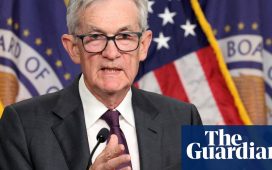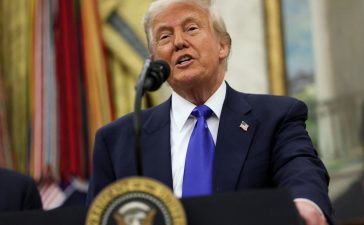US stocks gained for the second straight week as traders took dovish signals from the Federal Reserve after it slowed the pace of interest rate increases, while large tech companies reported a slowdown in growth.
Wall Street’s blue-chip S&P 500 fell 1 per cent on Friday, but gained 1.6 per cent over the week. The tech-heavy Nasdaq Composite slipped 1.6 per cent on Friday, while finishing the week 3.3 per cent higher.
A heavy sell-off in government bonds more than reversed large gains in Thursday’s session. The yield on the 10-year Treasury leapt 0.13 percentage points to 3.53 per cent, and the rate-sensitive two-year Treasury jumped 0.2 percentage points to 4.29 per cent.
Big central banks this week raised interest rates to their highest levels since the global financial crisis, yet investors rushed into equities and bonds after officials hinted that the current cycle of monetary tightening may be nearing its end. Investors were buoyed after Fed chair Jay Powell said the “disinflationary process” in the US economy was under way.
Earnings from Apple, Amazon and Alphabet showed sales growth softening in Silicon Valley, where many companies recently announced job cuts. However, Friday’s monthly jobs figures suggest the US economy remains resilient despite a significant monetary tightening over the past year, puncturing some optimism that the Fed would cut rates later this year.
The US added 517,000 jobs in January, much higher than the 185,000 anticipated by Wall Street economists. The economy added 260,000 in December. The jobless rate fell to a multi-decade low of 3.4 per cent, from 3.5 per cent the previous month.
“I’m shocked by these numbers,” said Steven Blitz, chief US economist at TS Lombard. “If they’re really reflective of what’s going on in the economy, one has to ask the question: what is the Fed doing slowing down with rates?”
Having previously forecast that the Fed would pause after another quarter percentage point increase in March, Blitz said he now expected the central bank to replicate the move at its meeting in May.
“Before these numbers we thought the Fed had maybe one more hike left in it, but today’s job numbers make me think there’s now at least another two to go,” Fitch Ratings chief economist Brian Coulton said.
Earlier in the week “markets seemed to be quite confident about fighting the Fed”, Coulton continued. “These numbers might just introduce some doubt.”
A measure of the dollar’s strength against a basket of six peers jumped 1.2 per cent, though the world’s reserve currency has declined almost 9 per cent since September.

Economic activity in the vast US services sector meanwhile grew more than expected, with the latest ISM non-manufacturing index rising to 55.2 per cent in January from 49.2 per cent in December. Economists polled by Reuters had expected a smaller improvement to 50.4 per cent.
Europe’s Stoxx 600 share index gained 0.3 per cent on Friday, with Germany’s Dax falling 0.2 per cent. London’s FTSE 100 rose 1 per cent to a record high. Yields on 10-year German Bunds and Italian government bonds of the same duration edged higher, retracing some of the strong gains in the previous session.
The moves come after the Bank of England and European Central Bank on Thursday raised rates by 0.5 percentage points, and with the Fed having increased its main policy rate by a quarter of a percentage point on Wednesday.
Prices for international oil benchmark Brent crude settled 2.7 per cent lower at $79.94 a barrel, while US benchmark West Texas Intermediate fell 3.3 per cent to $73.39.






